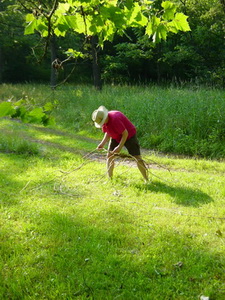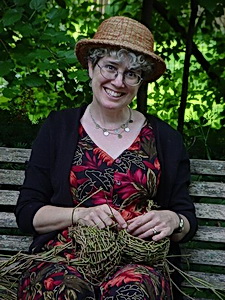
Green Wedding
Baskets
~FAQ~
Welcome!
- Green Wedding Baskets are made from sustainable, hand-collected, wild materials, mostly vines, but some grasses, herbs, leaves, etc. are used.
- How are Green Wedding Baskets different from other baskets?
Green Wedding Baskets are entiredly pesticide and chemical free. Grown, collected, woven in the USA. Responsibly collected, sustainably harvested, totaly Earth-friendly, eco-conscious and "green" in every sense of the word! - Why is this unusual or important?
Just about any basket you purchase from a florist or decorator is full of chemicals. Most decorator baskets are made in Indochina, from highly processed materials. Many of these materials are soaked in diesel fuel or other harsh chemical to strip bark, or soften them. This includes the "reed" material that most basketmakers in this country use. Once the material is processed and woven into a basket, it is packaged for import to the US. As a general practice, natural plant materials like reed and baskets are fumigated before they enter the United States, in order to kill any pests they may be harboring. So that's another blast of very strong chemicals. Many people believe exposure to chemicals causes health issues, and try to avoid chemicals and pesticides whenever possible. - What about other baskets labeled "organic?"
Yes, there are other baskets labeled "organic" on the market. Unfortunately, this is often used as a keyword or tag, and does not mean chemical or pesticide free. It is being used in the sense that the basket was made from a plant. If in doubt, ask! Good questions: Who made this basket? Where was it made? Were chemicals used in it's making or growing of the plants used to make it? Has it been treated with dyes, paints, or pesticides? - What else can I do with my basket?
Like any basket, they hold just about everything! Please line with a clean napkin before using to hold food items. When you are finished using your Green Wedding Basket, it makes a lovely container for use in your household, or natural display. They make great nest displays. If you are completely finished with it, feel confident adding it to your compost pile, and let it return to the earth in the same natural, gentle manner that all living things are meant to do. - Who makes these baskets?
Everything here is made by me, Pamela Zimmerman, and this means that I venture into the woods most days, year round, on my quest for materials. - How long does it take to make a basket?
Many baskets are ready to ship. Please allow several weeks for custom orders. It takes several days usually to make a basket: one to find and collect adequate material, a second to process material, and a third to weave the basket. Then the basket must dry. Drying time varies greatly, depending on time of year and weather. Baskets are generally not shipped until at least 1 week after their completion, to prevent mildew in transit! Natural moisture in these recently green, growing materials needs to be allowed to escape, so baskets are wrapped in paper (usually recycled) to aid in drying. - What materials are used?
Some of the materials that turn up in Green Wedding Baskets most often: wisteria, Virginia Creeper, English Ivy, grapevine, honeysuckle, porcelain vine, Carolina Jasmine, rosemary, and autumn olive. Some materials are only available at certain times of year. - About me:
I have been making baskets since 1998, and have always experimented with what I could find in the woods and my yard. I am mostly self-taught. My woven forms have been in hundreds of fine art shows across the country, in several books and many magazines and other printed publications. My "art" website is PamelaZimmerman.net - I want to learn! Do you teach?
Yes, I teach basketry, usually at the North Carolina Basketmaker's Association annual convention in March. But I generally do not teach vine basketry there. It is too difficult to gather enough material for a whole class. If you are interested in learning, I recommend Wild Pony Basket kits for learning basic wicker work, that's how I learned. Also, joining the Natural Fibers Group is a good place to find other people working with naturals who are willing to share their knowledge and experience. - If you have a question, please ask!


